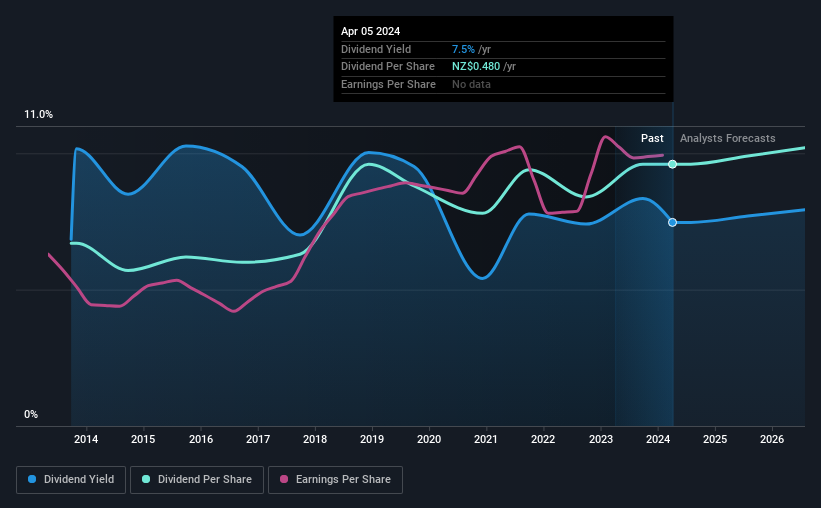Should Income Investors Look At Hallenstein Glasson Holdings Limited (NZSE:HLG) Before Its Ex-Dividend?
Regular readers will know that we love our dividends at Simply Wall St, which is why it's exciting to see Hallenstein Glasson Holdings Limited (NZSE:HLG) is about to trade ex-dividend in the next 4 days. The ex-dividend date is one business day before the record date, which is the cut-off date for shareholders to be present on the company's books to be eligible for a dividend payment. The ex-dividend date is important as the process of settlement involves two full business days. So if you miss that date, you would not show up on the company's books on the record date. Meaning, you will need to purchase Hallenstein Glasson Holdings' shares before the 10th of April to receive the dividend, which will be paid on the 18th of April.
The company's next dividend payment will be NZ$0.2590188 per share, on the back of last year when the company paid a total of NZ$0.48 to shareholders. Based on the last year's worth of payments, Hallenstein Glasson Holdings stock has a trailing yield of around 7.5% on the current share price of NZ$6.43. Dividends are a major contributor to investment returns for long term holders, but only if the dividend continues to be paid. That's why we should always check whether the dividend payments appear sustainable, and if the company is growing.
Check out our latest analysis for Hallenstein Glasson Holdings
If a company pays out more in dividends than it earned, then the dividend might become unsustainable - hardly an ideal situation. Its dividend payout ratio is 89% of profit, which means the company is paying out a majority of its earnings. The relatively limited profit reinvestment could slow the rate of future earnings growth. We'd be concerned if earnings began to decline. That said, even highly profitable companies sometimes might not generate enough cash to pay the dividend, which is why we should always check if the dividend is covered by cash flow. Thankfully its dividend payments took up just 46% of the free cash flow it generated, which is a comfortable payout ratio.
It's positive to see that Hallenstein Glasson Holdings's dividend is covered by both profits and cash flow, since this is generally a sign that the dividend is sustainable, and a lower payout ratio usually suggests a greater margin of safety before the dividend gets cut.
Click here to see how much of its profit Hallenstein Glasson Holdings paid out over the last 12 months.
Have Earnings And Dividends Been Growing?
Companies with consistently growing earnings per share generally make the best dividend stocks, as they usually find it easier to grow dividends per share. Investors love dividends, so if earnings fall and the dividend is reduced, expect a stock to be sold off heavily at the same time. This is why it's a relief to see Hallenstein Glasson Holdings earnings per share are up 3.4% per annum over the last five years. A payout ratio of 89% looks like a tacit signal from management that reinvestment opportunities in the business are low. In line with limited earnings growth in recent years, this is not the most appealing combination.
Another key way to measure a company's dividend prospects is by measuring its historical rate of dividend growth. In the past 10 years, Hallenstein Glasson Holdings has increased its dividend at approximately 3.7% a year on average. We're glad to see dividends rising alongside earnings over a number of years, which may be a sign the company intends to share the growth with shareholders.
Final Takeaway
Should investors buy Hallenstein Glasson Holdings for the upcoming dividend? While earnings per share growth has been modest, Hallenstein Glasson Holdings's dividend payouts are around an average level; without a sharp change in earnings we feel that the dividend is likely somewhat sustainable. Pleasingly the company paid out a conservatively low percentage of its free cash flow. It might be worth researching if the company is reinvesting in growth projects that could grow earnings and dividends in the future, but for now we're not all that optimistic on its dividend prospects.
While it's tempting to invest in Hallenstein Glasson Holdings for the dividends alone, you should always be mindful of the risks involved. For example, we've found 1 warning sign for Hallenstein Glasson Holdings that we recommend you consider before investing in the business.
If you're in the market for strong dividend payers, we recommend checking our selection of top dividend stocks.
Have feedback on this article? Concerned about the content? Get in touch with us directly. Alternatively, email editorial-team (at) simplywallst.com.
This article by Simply Wall St is general in nature. We provide commentary based on historical data and analyst forecasts only using an unbiased methodology and our articles are not intended to be financial advice. It does not constitute a recommendation to buy or sell any stock, and does not take account of your objectives, or your financial situation. We aim to bring you long-term focused analysis driven by fundamental data. Note that our analysis may not factor in the latest price-sensitive company announcements or qualitative material. Simply Wall St has no position in any stocks mentioned.

 Yahoo Finance
Yahoo Finance 
